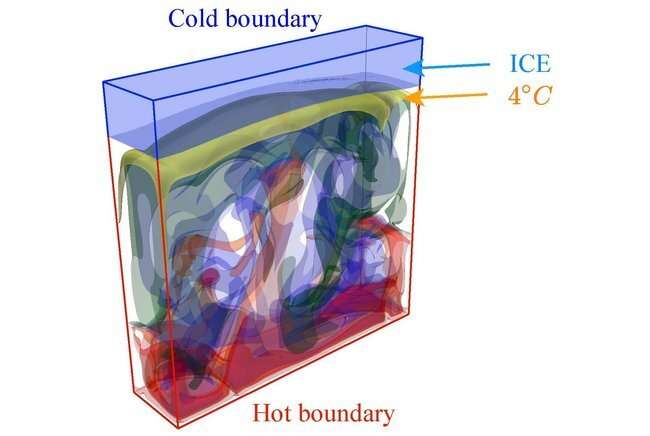How the growth of ice depends on the fluid dynamics underneath

Researchers of the Toschi group of Eindhoven University of Technology think the water phase change problem with considering the water density anomaly is of great importance relating to common natural phenomena. Their research plan is firstly to understand the physics fundamentals, that is, the coupled problem of the stably and unstably stratified layers with considering the density anomaly.
The current work is only the stepping stone to later explore more interesting yet complex icing problems. In future, they also plan to investigate the ice melting and formation with respect to the seawater, e.g. in the experiments adding salt to the system and in the simulation adding concentration scalar field coupled with the temperature field (which is the 'double-diffusive convection') to mimic the seawater.
Fluid dynamics can change system behaviors
Landscapes, resulting from ice–water interactions coupled with solidification/melting, are ubiquitous in nature, yet most previous studies have not considered the rich fluid dynamics induced by water density anomaly underneath the moving ice front, which can drastically change system behaviors. By experiments, numerical simulations, and theoretical modeling, researchers investigate water solidification and its dynamical coupling with (turbulent) convective flows.
We reveal four distinct regimes and develop a theoretical model capable of accurately capturing ice thickness and icing timescales. Physical mechanisms revealed from this study, when applied to geological recordings of lake ice, can provide an indicator of climate change. The current investigations offer deeper insight into understanding the coupling between phase change and stratification in marine, geophysical, and astrophysical systems.
Four distinct flow-dynamics regimes
Convective flows coupled with solidification or melting in water bodies play a major role in shaping geophysical landscapes. Particularly in relation to the global climate warming scenario, it is essential to be able to accurately quantify how water-body environments dynamically interplay with ice formation or melting process. Previous studies have revealed the complex nature of the icing process, but have often ignored one of the most remarkable particularities of water, its density anomaly, and the induced stratification layers interacting and coupling in a complex way in the presence of turbulence.
By combining experiments, numerical simulations, and theoretical modeling, researchers investigate solidification of freshwater, properly considering phase transition, water density anomaly, and real physical properties of ice and water phases, shown to be essential for correctly predicting the different qualitative and quantitative behaviors. The researchers identify, with increasing thermal driving, four distinct flow-dynamics regimes, where different levels of coupling among ice front and stably and unstably stratified water layers occur. Despite the complex interaction between the ice front and fluid motions, remarkably, the average ice thickness and growth rate can be well captured with the theoretical model. It is revealed that the thermal driving has major effects on the temporal evolution of the global icing process, which can vary from a few days to a few hours in the current parameter regime. The model can be applied to general situations where the icing dynamics occur under different thermal and geometrical conditions.
More information: Ziqi Wang et al. How the growth of ice depends on the fluid dynamics underneath, Proceedings of the National Academy of Sciences (2021). DOI: 10.1073/pnas.2012870118
Journal information: Proceedings of the National Academy of Sciences
Provided by Eindhoven University of Technology




















